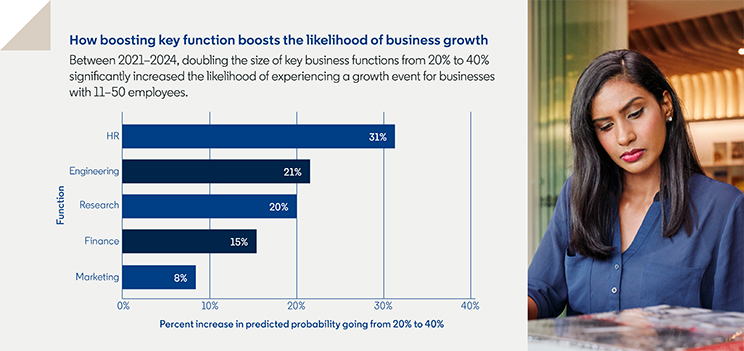
Understanding the DNA of High-Growth Businesses
Written by Sharat Raghavan, Director of Data Science at LinkedIn & Akash Kaura, Staff Data Scientist at LinkedIn
The economy today is uncertain, making the path to growth more complex than ever. Amidst this rapidly changing environment, businesses must capitalize on every possible advantage to unlock growth. Our Economic Graph Research Institute has partnered with Intuit Enterprise Suite to understand the shared traits of high-growth businesses so business leaders can set their organizations up for lasting success.
As a testament to the challenging business environment today, while 44% of businesses grew their employee base from 2021 to 2024, only 4.3% achieved high-growth i.e. moving from one company size category to another e.g. 11-50 to 51-200. Based on data from our newly published report, the proportion of high-growth businesses is down from 7.4% between 2016 and 2019. Our report shows that businesses can increase their chances of success by paying special attention to organizational structure, integrating cutting-edge technologies, and cultivating a culture of continuous learning.
Strategic Resource Allocation Matters for Growth
According to our data, high-growth businesses devote a higher share of their workforce to engineering, research, and finance functions. By growing these teams, businesses can improve their likelihood of achieving high growth by 15-30%. Engineering and research teams are often central to the development and adoption of cutting edge solutions and technologies like artificial intelligence (AI) that can unlock growth by multiplying the productivity and contributions of other teams across the organization. As Simon Worsfold, Head of Data Communications at Intuit highlights, “the need for automation including AI is clear. In our research, more than 8 out of 10 business leaders agree that manual data wrangling undermines productivity, employee morale, and even their profitability. With the time saved by automation, they can put all their focus on growth strategies and customer satisfaction.”

AI is a Growth Accelerant for Businesses
LinkedIn data shows that by 2030, the skills required for the average job are expected to shift by nearly 70% compared to 2015, with generative AI (GAI) accelerating that transformation. Leaders that integrate this technology effectively into their businesses stand to set themselves apart from their peers. Our data shows that high-growth businesses have 45.5% higher levels of AI skill development compared to their counterparts.

Between 2021 and 2024, businesses with employees having 1-10 GAI skills were twice as likely to experience a growth event as those with none. Businesses are already putting these GAI skills into action with 76% of businesses reporting substantial time savings across most job functions by using GAI in customer engagement, business development, and research and development.
Continuous Learning Drives Growth
High-growth businesses are not just cultivating AI skills at a faster pace than their peers, they have an organizational commitment to continuous learning. Businesses that experience growth events typically see over 60% more skills developed per employee than their counterparts that do not grow as quickly. Our data shows that across 2016-2019 and 2021-2024, accelerating skill development is strongly linked to high growth. By doubling the number of skills developed from 10 to 20, businesses can stand to improve their chances of achieving high growth by 40-60% showing the correlation between growth and a culture of continuous learning and skill development.

These key strategies all rely on a workforce that is willing and able to learn and develop new capabilities. Our report shows that businesses can achieve this by committing to creating a flexible workforce with diverse skills and knowledge. Breaking down internal silos and enabling internal mobility can help businesses connect information in new ways to address problems more effectively, and enable growth – indeed businesses that doubled internal mobility opportunities each year between 2021 and 2024 also doubled their annual chances of growth.
While growth may have become harder to capture, the combination of strategies businesses use and the speed at which they execute on them will set high-growth businesses apart.
